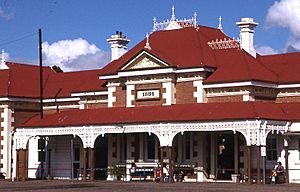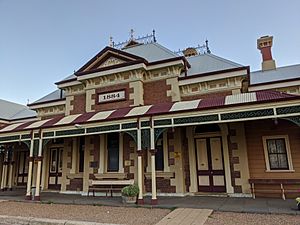Mudgee railway station facts for kids
Quick facts for kids Mudgee railway station |
|
|---|---|

Mudgee railway station, pictured in 2007.
|
|
| Location | Wallerawang-Gwabegar railway, Mudgee, Mid-Western Regional Council, New South Wales, Australia |
| Built | 1883–1884 |
| Architect | John Whitton |
| Owner | Transport Asset Holding Entity |
| Official name: Mudgee Railway Station, yard and locomotive yard | |
| Type | state heritage (complex / group) |
| Designated | 2 April 1999 |
| Reference no. | 1204 |
| Type | Railway Platform/ Station |
| Category | Transport - Rail |
| Lua error in Module:Location_map at line 420: attempt to index field 'wikibase' (a nil value). | |
The Mudgee railway station is a historic building in Mudgee, New South Wales, Australia. It was designed by a famous engineer named John Whitton and built between 1883 and 1884. This station is so important that it's listed on the New South Wales State Heritage Register, which means it's protected because of its special history and design.
Contents
The Story of Mudgee Railway
How the Railway Came to Mudgee
For a long time, people in Mudgee really wanted a railway line to connect their town to other places. They asked the government many times to build one. At first, the main railway line went to Bathurst instead of Mudgee.
But the people of Mudgee didn't give up! They formed groups, like the Mudgee Railway League, to keep asking for their own line. In 1879, their hard work paid off. The government finally decided to build a railway line from Wallerwang to Mudgee. A local leader, Sir John Robertson, was a big help in making this happen. He even turned the first bit of soil to start the construction in 1880.
Opening Day Celebrations
The railway line officially opened on 11 September 1884. It was a huge party for Mudgee! The celebrations started the day before with a special decorated train arriving. There was a big picnic in what is now Robertson Park. On the official opening day, bands marched through the streets to the station. A special train broke a ribbon to mark the opening. Everyone enjoyed a huge outdoor feast, followed by a fancy dinner and a dance in the evening. It was one of the most exciting days in Mudgee's history, showing how much the railway meant to the town after nearly 25 years of trying to get it built.
The Station's Design and Use
The station building was designed by John Whitton, who was the chief engineer for railways at the time. He made sure the Mudgee station was grand and important, showing how much the railway meant to the town. It was one of the most impressive stations he designed, only smaller than a few very big city stations.
Over the years, the station yard (the area around the tracks) has stayed mostly the same since 1883. However, some smaller buildings, like the Station Master's house, were taken down.
Passenger trains stopped coming to Mudgee in 1985. After that, the station building was used for different things. For a while, parts of it were turned into a restaurant, which opened in 2006. Later, it became an Indian restaurant, but that closed around 2015. Today, the station is used by local craft groups and as a meeting place for veterans.
What the Station Looks Like
The Station Yard
The railway yard at Mudgee is long and narrow, following the railway tracks. At one end, there's a concrete bridge. Near the station building, you can still see old structures like a furnace for warming feet and coal bins. The station is surrounded by a gravel parking area. To the east, there's a goods yard with a loading dock, a crane, and a weighbridge (a scale for weighing heavy items). Further east, you can find the old engine shed where trains were kept and repaired.
The Station Building
The main station building is made of red bricks with sandstone foundations and decorative corner blocks called quoins. The roof is made of corrugated iron and has a fancy design in the middle with decorative metal pieces called finials. There's also a date plaque on the building. The building has wings on each side, and a long awning runs along the side facing the tracks, providing shelter.
Inside, the rooms have high ceilings, which makes them feel very spacious. The walls are plastered, and many rooms still have their original wooden floors. The windows on the outside have arched tops, but inside they are square. One room still has its original fireplace, but most other old fittings have been removed over time.
Changes Over Time
The station has seen some changes since it was first built. For example, in 1911, a refreshment room and parcel office were added. Later, in 1917, an old room was turned into a bar. More changes happened in the 1920s to create more space for staff. Some windows were changed into doors, and parts of the brickwork were painted. In 1944, the current Parcels Office was built.
Why Mudgee Station is Special
The Mudgee railway station and its yard are very important because they are one of the best examples of a Victorian-era railway station that still exists today. Many of its original parts from when it opened in the 1880s are still there. It shows how confident people were about building railways during that time. Even when additions were made later, they were still built with high quality.
It's rare to find a station building like Mudgee's that hasn't had its outside brickwork painted. The station building, even with its additions, still looks much like it did originally. It's a major landmark in Mudgee and represents an important time in railway building after the gold rushes in western New South Wales.
The Mudgee railway station is listed on the New South Wales State Heritage Register because:
- It's beautiful and well-designed: It's a great example of a Victorian-style railway station. It's also a local landmark in Mudgee.
- It's rare: The station and its yard are special because they still have their original railway line and siding arrangements, which is very uncommon to see today.
- It shows what other stations were like: It's a good example of the large country railway stations built in the late Victorian period. It's especially good because it has kept so much of its original look and layout.


